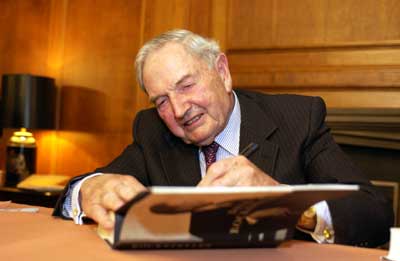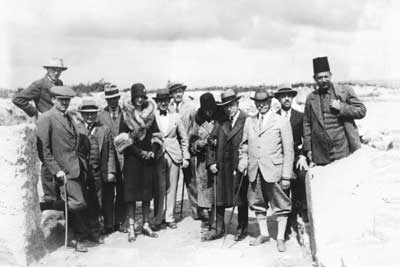 When
John D. Rockefeller Jr. received an invitation to visit
the Oriental Institute’s “dig” in Luxor,
Egypt,
his youngest son begged to tag along.
When
John D. Rockefeller Jr. received an invitation to visit
the Oriental Institute’s “dig” in Luxor,
Egypt,
his youngest son begged to tag along.
From the book Memoirs by David Rockefeller.
Copyright © 2002 by David Rockefeller published by
arrangement with Random House Trade Publishing, a division
of Random House, Inc.
Father was enthralled
by the discoveries of archaeologists who had uncovered
so much about the emergence of the great civilizations of
antiquity. As a young man he had taken a special interest
in the work of the University
of Chicago’s
Oriental Institute, headed by the distinguished Egyptologist
Dr. James Henry Breasted. For a number of years Father supported
Breasted’s work in Luxor
and at the Temple
of Medinet Habu
across the Nile just below the Valley
of the Kings.
In late 1928, Dr. Breasted invited Mother
and Father to visit his “dig” in Egypt
and to review the work of the institute. Neither of my parents
had ever been to that part of the world, and after some
discussion they readily agreed to go. I was in the ninth
grade at the time and quickly made it obvious to my parents
that I wanted to go with them. I had read about the discovery
of King Tutankhamen’s tomb only a few years earlier, and
a trip to Egypt
seemed to me the most exciting of adventures. Father was
concerned about my missing so much school because of the
length of the trip, which would last for more than three
months, but I finally persuaded him to let me go on the
grounds that I would learn so much from the experience.
He agreed on condition that a tutor went along to keep me
up to date on schoolwork. This was the best deal I could
get, so I eagerly agreed.
|
From
an Oriental Institute tour at Megiddo in 1929: David
Rockefeller is third from the left; his father, John
D. Rockefeller Jr., and his mother, Abby Aldrich Rockefeller,
are fourth and fifth from the right. James Henry Breasted,
founder of the Oriental Institute, is third from the
right. |
We sailed from New
York on the S.S. Augustus
in early January 1929. At the last moment Mary Todhunter
Clark, known as Tod, who was a close friend of [my brother]
Nelson’s from summers in Seal
Harbor, came
along as well.
In Cairo
we spent a week at the elegant old-world Semiramis Hotel,
where a colorfully dressed dragoman served as our interpreter
and guide. We visited the Sphinx, and I rode a camel out
to Giza, where
I climbed the Great Pyramid. We saw whirling dervishes dance
in the Arab Quarter one evening and visited mosques and
the ancient Arab university
of el Azhar.
Best of all for me were the bazaars, where I spent as many
hours as I could, fascinated by the women dressed in black
robes whose faces were always veiled, and by the exotic
wares sold by hundreds of small shopkeepers from their tiny
stalls facing onto narrow streets of the souk. The pungent
smells of the spice market, the sounds of hammering on copper
pots and bowls that were being fashioned, and the colorful
displays of rugs and textiles caught my fancy, and I quickly
learned to bargain for everything, offering but a fraction
of the listed price for anything I was interested in. There
were swarms of flies everywhere, clinging to freshly dressed
meat hanging from hooks in the butchers’ stalls, and hordes
of beggars, many of them children with trachoma who had
fluid running from their milky white eyes.
From Cairo
we headed up the Nile on a large
dahabiyah (a passenger boat) to see Dr. Breasted’s
excavations at Luxor.
I still remember the picturesque feluccas sailing
on the Nile, the farmers patiently
raising buckets of water from the river with shadoofs
(a counterbalanced sweep) to irrigate their fields, which
for centuries has fed millions of people in defiance of
the desert. There were many other important ancient sites
on the way, and each evening after we tied up along the
riverbank, Dr. Breasted gave a slide lecture on the monuments
we would see the following day.
After Luxor
and Karnak we continued on to the
Second Cataract at Wadi Halfa, the first town in the Sudan.
On the way we passed the beautiful Temple
of Philae, now
submerged under Lake
Nasser following
the construction of the High Dam at Aswan
in the 1960s. We also saw the magnificent Temple
of Ramses II
at Abu Simbel with its four colossal
statues of a pharaoh carved into the face of the cliff.
Half a century later I visited Abu Simbel
again after the entire temple, including the great statues,
had been cut free and lifted hydraulically to the top of
the cliffs, to protect it from the rising waters of the
Nile behind the Aswan Dam. Reinstalled
in this new setting in front of an artificial cliff, it
looked as imposing as when I had first seen it in 1929.
I continued to pursue my interest in
beetle collecting and even managed to find a sacred scarab,
a beetle that lays its eggs in a ball of dung and then buries
it in the sand. The ancient Egyptians worshiped the sacred
scarab, believing it to be an intermediary between the living
and the underworld of the dead. Tod playfully teased me
about my hobby, so I bought an inexpensive wedding ring
and gave it to her in the presence of my parents and others,
claiming that I represented Nelson in asking for her hand
in marriage. Everyone except Tod thought this was quite
amusing, since we all knew she had high hopes for just such
an event. Indeed, soon after we returned from the trip,
Nelson did propose, and they were married the following
year.
We also visited the Cairo Museum of Antiquities
and found it in appalling condition with mud-encrusted sarcophagi
and beautiful ornaments resting on bare shelves, poor lighting,
and inadequate identification. In 1925, at Dr. Breasted’s
urging, Father had offered $10 million to rebuild the museum
in order to provide a better setting for the world’s greatest
collection of antiquities. Inexplicably, the Egyptian government
refused, and Father always suspected it was the result of
pressure from the British government, which was not anxious
to see an intrusion of American influence even in cultural
affairs.
 Photograph by
Dan Dry
Photograph by
Dan Dry |
David
Rockefeller returned to Chicago’s International
House on November 7 for a discussion of Memoirs with
U of C President Randel. Several hundred people attended
the program and the book-signing reception that followed. |
We drove on to Palestine
through the Nile delta and along
the coast. We toured the holy places in Jerusalem
and traveled down to Jericho,
where I took a swim in the salty Dead Sea,
a thousand feet below sea level. We then proceeded north
to Beirut through
the Jordan Valley
and along the Sea of Galilee. The
associations of this area with the Bible and the ministry
of Jesus Christ made this a deeply meaningful part of the
trip for Father and, I confess, for me as well.
Although Father’s proposal to build a
new museum in Cairo
foundered on the rocks of international politics, he was
much more successful with a similar idea in Jerusalem.
Wandering the Via Dolorosa, visiting Bethlehem,
the Garden of
Gethsemane, the
Dome of the Rock, and the Wailing Wall on the site of the
Second Temple
convinced Father that something needed to be done to preserve
the antiquities of the Holy Land
after centuries of neglect by the Ottoman Turks. Again,
with Dr. Breasted’s encouragement, Father offered to build
a museum of archaeology to house these antiquities and provide
the facilities for scholars to study them. This time the
British government, which controlled the Palestinian
Mandatory State,
agreed with the proposal wholeheartedly. The Palestine
Archaeological Museum,
often referred to today as the Rockefeller
Museum, still
exists in east Jerusalem
and houses, among many other marvelous things, the Dead
Sea Scrolls.
Looking back I realize the debt I owe
to my parents for my education. While the Lincoln
School did a
creditable job in providing me with a formal education,
my parents did more. They brought to our home some of the
most interesting people of the time. On our many trips and
excursions they opened our eyes to nature, to people, and
to history in a way that expanded our interests and stimulated
our curiosity. They made us feel the excitement of the opportunities
open to us and recognize the role the family was playing
in so many areas. These experiences gave us an education
that transcended formal learning.


![]() Contact
Contact
![]() About
the Magazine
About
the Magazine ![]() Alumni
Gateway
Alumni
Gateway ![]() Alumni
Directory
Alumni
Directory ![]() UChicago
UChicago![]() ©2002 The University
of Chicago® Magazine
©2002 The University
of Chicago® Magazine ![]() 5801 South Ellis Ave., Chicago, IL 60637
5801 South Ellis Ave., Chicago, IL 60637![]() fax: 773/702-0495
fax: 773/702-0495 ![]() uchicago-magazine@uchicago.edu
uchicago-magazine@uchicago.edu

